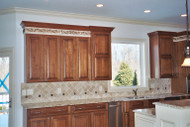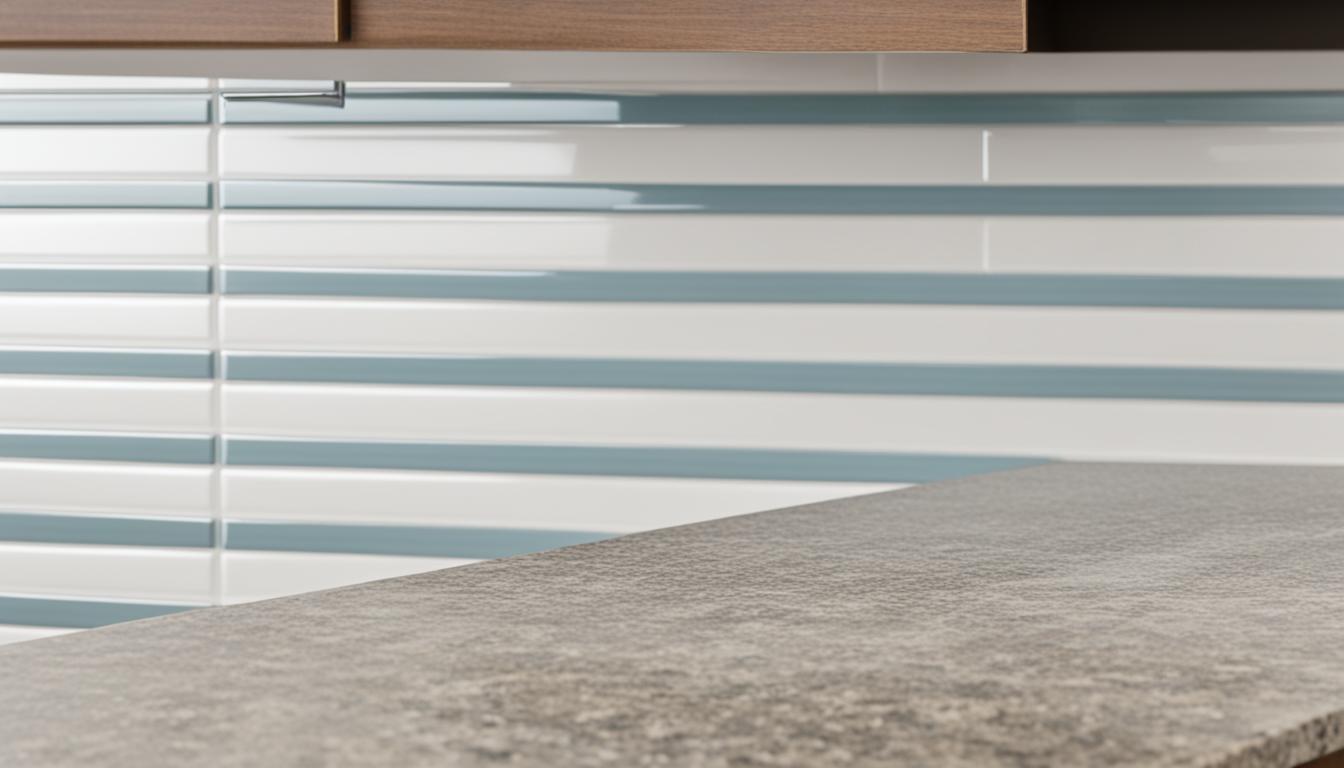Where to End Kitchen Backsplash Tiles
Posted by Mike Belk on Jan 17, 2019

Adding the right backsplash to your kitchen is a mix of style and practicality. It's key to know where to begin and end for a great look. Experts say aligning backsplashes with cabinets is crucial for a unified look, whether your kitchen is big or small.
Choosing wisely about space, budget, and layout is also important. This ensures your backsplash installation goes smoothly.

Key Takeaways
- Tile main kitchen walls, ending at corners for a clean transition.
- Full-wall backsplashes benefit smaller kitchens for a seamless finish.
- Large kitchens should end backsplashes in line with upper cabinets to avoid an overloaded look.
- Align upper and lower cabinets with backsplash edges to maintain a crisp line.
- Consider a countertop-to-ceiling backsplash for a high-end aesthetic.
- Faux tin or PVC backsplashes offer cost-effective alternatives to premium tiles.
By using these design tips, you can make your kitchen look great and stay within budget. These tips improve both the look and use of your kitchen space.
Introduction to Backsplash Placement
Backsplash placement is key in kitchen design, affecting both looks and function. It protects walls from moisture and splatters. It also adds design flair. Exploring different backsplash ideas can help create a unified kitchen look.
Tile backsplash projects vary due to differences in tile size, shape, and height. Electrical outlets, windows, and where the backsplash ends also play a part. Each design should focus on key areas like range hoods or corners.
Keeping the running bond pattern is important. Begin with a full tile at the countertop and adjust the top row to fit the cabinets. This layout should flow smoothly from one wall to another, especially around corners.
It's best to avoid small slivers of tile near cabinets or trim. Symmetry is crucial, especially with mosaic tiles. The tiles near the mosaic edge should be full or half to look intentional and polished.
Here are some additional considerations:
- A new tile backsplash can be completed in a single weekend.
- Manufacturer's specifications often recommend a 1/8-inch trowel notch size for applying thin-set mortar.
- Use tile spacers to maintain consistent joints between tile sheets.
- Allow around 12 hours for the thin-set mortar to set.
- Ensure grout is worked into the joints vertically, horizontally, and diagonally.
- Apply grout sealer to reduce the likelihood of staining and for easy maintenance.
- Caulk where the backsplash meets the upper cabinets to complete the installation.
By using these tips, you can make a kitchen that looks good and works well. It will protect your walls from moisture and splatters.
General Rule for Backsplash Installation
Knowing the general rule for backsplash installation is key for a great kitchen look. Planning where to start and stop your backsplash is important for both looks and use.
Tiling the Cabinet Walls
Tiling the walls behind cabinets is a top choice, giving full coverage where it's needed most. Remember to buy 10% more tile for cuts and waste. Make sure the wall is smooth and clean before you start.
Leave a ⅛ inch gap between the tile and cabinets or countertop for expansion and contraction. Mesh-backed tiles are popular for easy installation.
Handling Odd Corners
Odd corners, like those around pipes or wonky walls, need extra care. Tiling the whole corner keeps the look uniform. Always wear safety glasses when cutting tiles.
Choosing materials has its pros and cons. Large porcelain tiles might need a wet saw for cuts, while smaller projects can use a tile cutter. Edge trim in materials like metal, plastic, or molding can finish your project nicely, matching your design.
Finishing at the ends of counters, upper cabinets, or a bulkhead looks neat and fits the kitchen well.
| Material | Pros | Cons |
|---|---|---|
| Tempered Glass | Easy to clean, visually appealing | Expensive, installation challenges |
| Tiles | Variety of designs, durable | Grout needs upkeep, can be time-consuming to install |
| Solid Panels | Sleek look, minimal seams | High cost, heavy |
| Quartz/Sintered Stone | Durable, heat-resistant | Costly, requires professional installation |
| Stainless Steel | Heat resistant, easy to clean | Can dent, fingerprints show easily |
Following these rules and techniques will make your backsplash both beautiful and practical. Learning backsplash endpoint techniques and checking out kitchen backsplash ideas will help you make a space that looks great and works well.
Full-Wall Backsplash Considerations
Installing a full-wall backsplash can make your kitchen look better and work better. It covers the whole wall area between countertops and cabinets, or goes up to the ceiling. This design is popular because it looks streamlined and cohesive.
A full-wall backsplash makes small kitchens look bigger and cleaner. It's great for galley kitchens because it makes the space feel larger and more welcoming. Plus, it means you don't have to cut tiles, keeping the design smooth.
When thinking about a full-wall backsplash, know the costs and what materials you can choose from. Here are some important points:
- Material and Design Choices: You can pick from ceramic, subway tile, glass, and stainless steel. Each has its own look, so pick one that fits your kitchen layout suggestions.
- Cost Considerations: Full-wall backsplashes cost more because they need more material and work. Getting a pro to install it can cost between $2,500 to $3,000.
- Seam Management: Big backsplashes might show seams. Talk to your installer about how to reduce seams for a better look, but it might cost more.
- Installation Complexity: Putting in a full-wall backsplash is harder and usually needs a pro to get it right.
- Maintenance and Cleaning: This option is easier to clean because there's no wall space above the backsplash, making upkeep simpler.
Choosing a full-wall backsplash should match your kitchen layout suggestions and what you like. It's a more expensive and harder option, but it can really improve your kitchen's style and function. It adds luxury and sophistication, which could also raise your home's value.
| Standard Backsplash | Full-Wall Backsplash |
|---|---|
| Height: 3-18 inches (most common: 15 inches) | Height: Covers entire wall to ceiling |
| Materials: Ceramic, subway tile, glass, stainless steel | Materials: Ceramic, subway tile, glass, stainless steel |
| Cost: More affordable, especially for DIY | Cost: Higher due to more material and labor |
| Installation: Easier, less labor-intensive | Installation: More complex, may need professional |
| Cleaning: Some exposed wall areas | Cleaning: Easier, no exposed wall areas |
Balancing Large Kitchen Spaces
Larger kitchens bring both chances and challenges in design, especially with a large kitchen backsplash design. Going all the way to the ceiling with the backsplash might be too much. Ending it at the upper cabinets creates a nice look and balance.
Using a color contrast with the tiles against the walls is another smart move. This makes the aesthetic kitchen enhancements stand out and adds warmth. You can choose from many styles to make your kitchen look great, like a 15-inch backsplash height that you can adjust as needed.
A good design balances looks and function. Using different tile sizes, like 6 inches below the cabinets, keeps the look together and stops water from splashing on the walls. Think about your kitchen's size, cabinet heights, and how your family uses the space. This planning makes your kitchen unique and functional.
| Material Options | Style Impact | Popularity |
|---|---|---|
| White Arabesque Tile | Classic Elegance | 63.7K shares on Pinterest |
| Gray Marble Chevron | Modern Sophistication | 25.1K shares on Pinterest |
| Glass Tile with Navy Blue Cabinets | Contemporary Chic | Featured in numerous kitchen remodels |
For the best results, get professional advice and choose the right materials. This way, your large kitchen backsplash will match your home's style, improving both looks and function. The right choices turn your kitchen into a key part of your home.
Where to End Your Backsplash Horizontally
Deciding where to end your backsplash can greatly affect your kitchen's look and feel. A balanced approach makes your kitchen both useful and visually appealing.
Aligning with Upper and Lower Cabinets
For a smooth look, align the backsplash with your cabinets' edges. This method is popular because it creates a pleasing line. It makes your kitchen look clean and organized, even if the backsplash goes over the countertop a bit.
Using bullnose trim tile can make these edges look even better. These tiles match the main tile in material, color, and finish. This approach gives your kitchen a polished look, avoiding any rough spots.
Managing Peninsula Kitchens
In peninsula kitchens, like those with U- or L-shapes, keep the backsplash's end point consistent. It should stop where the upper cabinets end, creating a clear line. This makes your backsplash look cohesive and elegant.
For open walls, you can use floating shelves or a border of different tile to mark where the backsplash ends. This keeps the look neat and stylish.
To see how different methods work, check out the table below. It shows some common ways to finish a backsplash in various kitchens:
| Method | Materials Used |
|---|---|
| Bullnose Trim | Tile in the same material, color, and finish |
| Contrasting Tile Border | Different colored or patterned tile |
| Floating Wall Shelves | Wood, glass, or metal shelves |
| Caulking | Silicone caulk or similar sealant |
| Wainscotting | Wood or beadboard panels |
| Mirrored Stops | Large wall mirror |
| Tapered or Hexagonal Tiles | Tapered or uniquely shaped tiles |
| Aluminum/Steel Trims | Metal trims in various profiles |
With these tips, your kitchen can look sophisticated, functional, and stylish.
Dealing with Windows and Small Wall Spaces
Windows and small wall spaces can be tricky in your kitchen. Treat windows as part of the wall for a seamless look. This keeps the visual line continuous and makes the design cohesive. It's great for fitting your backsplash into tricky spots without messing up the look.
Small wall spaces, like those between cabinets or near the countertop, need creative solutions. Here are some tips:
- Aligning tiles with cabinetry: This gives a clean edge and keeps things visually straight.
- Tapering off the backsplash: Slowly decrease tile height at the top to avoid harsh cuts.
- Framing specific areas: Use bullnose trim tiles or borders to highlight tile sections.
- Extending materials: Bring countertop materials onto the wall for a unified look.
For finishing touches, try different materials like aluminum, steel, and PVC. You can also use floating wall shelves, wainscotting, and mirrors to make small wall spaces look better.
For a clean and cohesive look, run your backsplash between upper and lower cabinets. This makes the room look bigger and keeps the design flowing well. It's important to stop the backsplash at natural points like walls, windows, or cabinet edges for a balanced look.
Tiling Above Sidesplashes
Tiling above sidesplashes needs a good plan. Using smart sidesplash installation tactics can make your kitchen look better and work better. By lining up sidesplashes with countertops and upper cabinets, you get a smooth and planned look.
Using Sidesplashes Strategically
Putting in sidesplashes is more than just placing tiles on the counter. Here are some smart sidesplash installation tactics:
- Aligning with Upper Cabinets: Make sure the sidesplash matches your upper cabinets for a neat look.
- Extending Around Windows: Add the backsplash around windows for a uniform design.
- Coordinating with Peninsula Edges: Tile to the end of a peninsula’s countertop or the edge of the furthest upper cabinet for a unified look.
Avoiding Awkward Stopping Points
It's important to avoid awkward stops for a clean finish. Use these backsplash border ideas:
- Stop at Logical Terminals: Finish the backsplash at kitchen boundaries like the bottom of range hoods or upper cabinet edges.
- Minimize Excess: Don't add backsplash tiles to walls unless they get splashes, like near water or grease.
- Maintain Alignment: Keep the backsplash in line with countertops and upper cabinets for a balanced design.
| Backsplash Install Points | Recommended Practices |
|---|---|
| Above countertops | Start the backsplash at the top edge of countertops |
| Around windows | Extend backsplash to keep the design consistent |
| Behind sinks and stoves | End at logical spots like range hoods |
| Peninsulas | Tile to the end of the countertop or furthest upper cabinet |
Tiling above sidesplashes needs careful attention to detail and smart design. Using these sidesplash installation tactics and backsplash border ideas will help you get a kitchen that looks great and works well.
Optimizing Modern Slab Backsplash Designs
For a sleek look, designing and installing a modern slab backsplash needs precision. It's important to line up the slab perfectly where cabinets and countertops meet. This ensures your kitchen looks great and works well.
There are many natural stones you can use for a modern slab backsplash. These include granite, marble, quartzite, and soapstone. Each stone has its own benefits and things to consider:
- Granite: Very strong and can handle heat and scratches well. But, it might need sealing to stop stains.
- Marble: Looks elegant but can get scratched and stained easily, especially by acidic foods.
- Quartzite: Looks beautiful and is very durable, handling heat and scratches well.
- Soapstone: Has a special matte look, is heat and stain-resistant. You should oil it regularly to keep it looking good.
Choosing a modern slab backsplash is a bit pricier and harder to install. Schlumberger suggests hiring professionals for the job because stone slabs are heavy and hard to handle. This way, you get a perfect install without damaging the stone.
| Material | Durability | Maintenance | Cost |
|---|---|---|---|
| Granite | High | Requires sealing | High |
| Marble | Moderate | Prone to scratching and staining | High |
| Quartzite | High | Low | High |
| Soapstone | Moderate | Requires regular oiling | Moderate |
Slab backsplashes give a smooth look by reducing grout lines. They're perfect for busy kitchens because they're strong. Even though they cost more, their beauty and usefulness make them a smart choice.
Traditional Backsplash Techniques
Traditional backsplash styles bring a timeless warmth to kitchens. They mix practicality with beauty. It's key to know the techniques and materials for this look to get a kitchen that's both beautiful and useful.
Adding Character with Classic Materials
Using materials like ceramic, porcelain, and natural stone makes your kitchen feel traditional. Ceramic tiles are versatile and affordable, offering many design options. Porcelain tiles look like marble and are easy to clean, adding a stylish touch. Natural stone gives a luxurious feel but costs more and needs more care.
To keep natural stone looking great, apply a pre-sealer before grouting. This helps prevent stains.

Utilizing Decorative Trim
Decorative trim is great for traditional backsplashes. It adds character and finishes the look where the backsplash meets other kitchen parts. This avoids awkward spots and makes the kitchen look unified.
When installing, use backer board screws that are 1 1/4 inches long. Keep panels apart by 1/8 inch and seal gaps with silicone to stop moisture from getting in.
- Add 10 percent of the total tile area for small gaps or replacements.
- Thin-set mortars can be used up to 4 hours after mixing.
- Let mortar and tiles dry for 24 hours before moving on.
- Grout must dry fully before applying a sealer to protect against stains.
Traditional backsplashes, with their classic touches and careful selection of materials, can turn your kitchen into a place of timeless beauty and function.
Techniques for Edgy and Unique Backsplashes
Personalization is key in today's world, making kitchens a reflection of style. Edgy backsplash ideas bring a unique touch to the kitchen. Hexagonal tiles add an irregular edge, perfect for a relaxed, modern look. They work well where symmetry isn't the main focus.
For a unique backsplash installation, choose innovative techniques and materials. Glass tiles, at up to $20 per square foot, add shine and depth. Beveled tiles bring texture and elegance with their sloped edges.
| Material Type | Cost per Square Foot | Benefits |
|---|---|---|
| Regular Tiles | $4 | Cost-effective, readily available |
| Glass Tiles | $30 | Reflective, sophisticated appearance |
| Beveled Tiles | $15 | Elegant, adds depth with texture |
| Porcelain Tiles | $10 | Moisture-resistant, highly durable |
Draw inspiration from different kitchen styles for your backsplash. For a rustic feel, use stone or terracotta. For a modern look, consider metal or sleek ceramic shapes. If you prefer classic elegance, go for subway tile, marble, or mosaic.
Personalizing kitchen spaces is a growing trend, with 77 inspiring ideas expected in 2024. Experts in East Tennessee stress the need for durable and easy-to-maintain materials. With professional advice, your backsplash can complement your cabinets perfectly, balancing looks and function.
These techniques not only highlight edgy backsplash ideas but also ensure a backsplash that lasts. Embrace these innovative methods to turn your kitchen into a masterpiece.
Cost-Saving Tips for Backsplash Installation
Installing a backsplash can be exciting but also a bit challenging. With the right planning and choices, you can keep your budget in check while still getting style and functionality.
Start by looking at the materials you can use. Ceramic tiles are a great choice and won't break the bank. They range from $1.25 to $15 per square foot. For a touch of luxury, go for ceramic tiles with a metallic finish, priced between $10 and $50 per square foot. Handmade tiles with intricate designs are pricier, costing $50 to $100 per square foot.
Glass mosaic tiles are another option, averaging $18 to $30 per square foot. If you want something more budget-friendly, consider laminate backsplashes, which are $3 to $11 per square foot. Vinyl tiles offer another affordable choice, priced between $2 and $10 per square foot.
Don't forget about wallpaper as a creative option. It costs between $15 to $50 per roll and can add a unique look to your kitchen. Plus, it's a great way to complement more expensive tiles by using them as accents.
To save money, mix high-end and affordable materials. Use expensive tiles as highlights in a field of cheaper tiles for a stunning yet budget-friendly look.
Doing the installation yourself can also help cut costs. A tiling backsplash project usually takes 2-3 days to complete. Day one is for hanging tiles, day two for grouting and finishing touches, and the third day for final preparations. Make sure you have the right tools like spacers, mortar, and levels to ensure a professional finish. Renting these tools can also save you money.
By following these tips and planning your budget carefully, you can create a beautiful and functional kitchen without spending too much.
Where to Start and Stop Your Backsplash
Deciding where to start and stop your backsplash can make your kitchen look better and work better. A good rule is to line up the backsplash with the cabinets' edges. This makes your kitchen look neat and well-planned.

In small kitchens, covering the whole wall with backsplash is best for a clean look. This is great for kitchens in apartments or condos. But in big kitchens, ending the tile where the range hood or cabinets start can look better. It keeps the design balanced and nice to look at.
Planning how to end your backsplash is key when remodeling. Make sure the new backsplash goes at least 1/4" above where the old one was. This makes finishing touches easier and looks more professional.
If your kitchen has windows, tile to the counter's end instead of stopping at cabinets. This makes the design flow better. For kitchens without upper cabinets, you can tile the wall all the way up or match the backsplash line around the room.
These methods make your kitchen work better and look nicer. They also add to the room's beauty.
Using different trim options can also help. For example, a short backsplash with a shelf on top can solve height issues. Adding a second material can make it look fancy and layered.
| Area Type | Start/Stop Technique |
|---|---|
| Small Kitchens | Fully cover the wall for a neat finish |
| Large Kitchens | End tile at the range hood line for balance |
| Kitchens with Windows | Continue tile to the end of the counter |
| L- or U-Shaped Kitchens | Tile full height or continue upper line around the room |
Using these tips can make your kitchen look and work better. It ensures a smooth and polished look everywhere.
Conclusion
Our backsplash installation guide shows how important the placement and finishing are for a great kitchen look. Making sure the backsplash matches your kitchen's style and cabinets makes it look smooth and nice. The choice of materials like tile, stone, glass, stainless steel, or copper changes the kitchen's look and use.
When planning your backsplash, remember to order extra tile for mistakes and cuts. This step helps avoid delays. Also, know that the project takes at least a weekend to finish, and you'll need more time for the thinset to dry before grouting.
Adding a backsplash is a smart way to update your kitchen without spending a lot. The tips in this guide stress the need for careful planning and choosing the right materials. With these tips, both homeowners and designers can make their kitchens look and work better.
FAQ
Where should I start and stop my kitchen backsplash?
Experts suggest covering the main kitchen walls with the backsplash. This means from wall to wall and up to the ceiling if you can. The tile should stop where the upper cabinets and walls end. This avoids awkward looks.
How do I handle backsplash placement in smaller kitchens?
In smaller kitchens, a full-wall backsplash works well. It makes the space look neat and bigger. Try not to cut tiles too small to keep the design smooth.
What are the general rules for backsplash installation?
Tile only the main walls behind the cabinets and stop at corners. This avoids covering non-useful areas. For odd corners, tiling the whole corner keeps the look consistent.
How do I manage backsplash placement in larger kitchens?
In big kitchens, stop the backsplash where the upper cabinets end. This creates a neat look. Adding a color contrast with the tiles can make the space feel cozier.
Where should the backsplash end horizontally?
The backsplash should line up with the cabinets' edges, both top and bottom. In kitchens with a peninsula or U-shape, stop where the upper cabinets end. This keeps the look clean.
How should I deal with backsplashes around windows and small wall spaces?
Tile around windows and small areas as if the window wasn't there. This keeps the look continuous. For stovetops, tile up to a hood for a unified look.
Should I include sidesplashes in my backsplash design?
Sidesplashes can be useful and look good if placed right. They should line up with kitchen features for order. But, simple designs might skip them for cleaner lines.
What are some tips for installing modern slab backsplashes?
Modern slab backsplashes need careful installation for a sleek look. Make sure cabinets and countertops fit perfectly for a contemporary style.
How can I add character to a traditional backsplash?
Traditional backsplashes are more flexible. Adding decorative trim can improve the look and finish. This is especially true where the backsplash ends on its own.
What are some unique backsplash installation ideas?
For a modern look, use tiles like hexagons for an edge. This creates interesting spots in the kitchen and lets you play with colors and placement.
How can I save costs while maintaining a stylish backsplash?
Use high-end materials and save money by choosing a shorter backsplash or less expensive tiles. This keeps the kitchen both beautiful and functional without spending too much.



